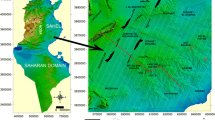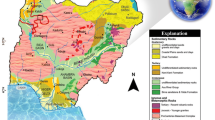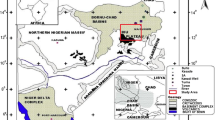Abstract
Ijebu-Ode and its environs in southwestern Nigeria is located on a geological transition zone from the Precambrian migmatite gneiss rocks and Cretaceous sedimentary rock units of Abeokuta Group. Unique geological structures, complex coexistence of different rock types and poorly defined basal/lateral contacts between the basement and sedimentary rocks typify tectonic events that accompany crustal thinning and downwarping at the basement/sedimentary-basin edge. This posed serious geological decision challenges especially since it is difficult to characterize the area either as sedimentary or crystalline. Aeromagnetic data were collected, the data were filtered, inverted and enhanced using appropriate software packages and subsequently employed to generate model of the subsurface basement topography.
The magnetic intensity distribution in the field ranged from −120 to +80 nT and was found to depend on the size, depth of burial and the thickness of low susceptibility superficial material overlying the magnetite rich crystalline rocks. High magnetic intensity characterized the basement rocks while lower values distinguished the metasediments rocks and sedimentary terrain. The average radial power analysis delineated shallow and relatively deep sources as the two distinct types of magnetic anomalies. Euler deconvolution results referenced to the Minna, Nigeria datum indicate depth range from −80 to +30 m for sources located below and above the mean ground level, respectively. Euler result also revealed that the depth to magnetic sources is heterogeneous and highly erratic around the transition zone, ranging between −25 and +12 m.
This study identified rugged and undulating basement topography around the contact zone; it also delineated the lateral and basal contacts between the two coexisting rock types. Aeromagnetic mapping of basement sedimentary transition zone around Ijebu-Ode has proved very efficient in providing relevant information about the nature of the basement topography which provided vital information requisite for drilling and some engineering constructions decisions.














Similar content being viewed by others
References
Ball E (1980) An example of very consistent brittle deformation over a wide intra continental area: the late Pan-African fracture system of the Tuareg and Nigerian shield. Tectonophysics 61:363–379
Baranov V, Naudy H (1964) Numerical calculation of the formula of reduction to the magnetic pole. Geophysics 29:67–79
Blakely RJ, Simpson RW (1986) Approximating edges of source bodies from magnetic or gravity anomalies. Geophysics 51:1494–1498
Briggs IC (1974) Machine contouring using minimum curvature. Geophysics 39:39–48
Carmichael RS (ed) (1982) Practical handbook of physical properties of rocks and minerals. CRC Press, Boca Raton
Clark DA, Emerson DW (1991) Notes on rock magnetization characteristics in applied geophysical studies. Explor Geophys 22:547–555
Cooper GRJ (2008) Euler deconvolution with improved accuracy and multiple different structural indices. J China Univ Geosci 19(1):72–76
Dobrin MB, Savit CH (1988) Introduction to geophysical prospecting, 4th edn. McGraw-Hill, New York
El Dawi MG, Liu T, Shi H, Luo D (2004) Depth estimation of 2-D magnetic anomalous sources by using Euler deconvolution method. Am J Appl Sci 1(3):209–214
Fedi M, Florio G (2006) CALFUN: 3D analysis of potential field scaling function to determine independently or simultaneously structural index and depth to source. In: 76 SEG annual meeting, New Orleans, 1–6 October, pp 963–967
Griffin WR (1949) Residual gravity in theory and practice. Geophysics 14:39–56
Hsu KS, Coppens D, Shyu CT (2002) Depth to magnetic source using the generalized analytical signal. Geophysics 63(6):1947–1957
Jones HA, Hockey RD (1964) The geology of part of southwestern Nigeria. Bull - Geol Surv Niger 31:101
Keating P, Zerbo L (1996) An improved technique for reduction to the pole at low latitudes. Geophysics 61:131–137
McMurry P (1976) The geology of the precambrian to lower palaeozoic rocks of northern Nigeria—a review. In: Kogbe CA (ed) Geology of Nigeria. Elizabethan, Lagos
Milligan PR, Reed G, Meixner T, FitzGerald D (2004) Towards automated mapping of depth to magnetic/gravity basement—examples using new extensions to an old method. In: ASEG 17th geophysical conference and exhibition Sydney
Mushayandebvu MF, Driel PV, Reid AB, Fairhead JD (2001) Magnetic source parameters of two-dimensional structures using extended Euler deconvolution. Geophysics 66:814–823
Nabighian MN (1972) The analytic signal of two-dimensional magnetic bodies with polygonal cross-section—its properties and use for automated anomaly interpretation. Geophysics 37:507–517
Nabighian MN (1984) Toward a three-dimensional automatic interpretation of potential field data via generalized Hilbert transforms-fundamental relations. Geophysics 49:780–786
Nabighian MN, Grauch VJS, Hansen RO, Lafehr TR, Li Y, Peirce JW, Phillips JD, Ruder ME (2005) 75th anniversary, the historical development of the magnetic method in exploration. Geophysics 70(6):33ND–61ND
Osinowo OO, Olayinka AI (2012) Very low frequency electromagnetic (VLF-EM) and electrical resistivity (ER) investigation for groundwater potential evaluation in a complex geologic terrain around Ijebu-Ode transition zone, southwestern Nigeria. J Geophys Eng 9(4):374–396
Osinowo OO, Akanji AO, Akinmosin A (2011) Integrated geophysical and geotechnical investigation of the failed portion of a road in basement complex terrain, southwestern Nigeria. RMZ - Mater Geoenviron 58(2):143–162
Reid AB, Allsop JM, Granser H, Millett AJ, Somerton IW (1990) Magnetic interpretation in three dimensions using Euler deconvolution. Geophysics 55:80–91
Roest WR, Verhoef J, Pilkington M (1992) Magnetic interpretation using the 3-D analytic signal. Geophysics 57(1):116–125
Spector A (1968) Spectral analysis of aeromagnetic data. PhD thesis, University of Toronto
Spector A, Grant FS (1970) Statistical models for interpreting aeromagnetic data. Geophysics 35(2):293–302
Talwani M, Heirtzler JR (1964) Computation of magnetic anomalies caused by two dimensional structures of arbitrary shape. Stanford University Publications of the Geological Sciences, Computers in the Mineral Industries
Talwani M, Worzel JL, Landisman M (1959) Rapid gravity computations for two dimensional bodies with application to the Mendocino submarine fracture zones. J Geophys Res 64:49–59
Thompson DT (1982) EULDPH—a new technique for making computer-assisted depth estimates from magnetic data. Geophysics 47:31–37
Acknowledgements
We thank the two anonymous reviewers for helpful comments and suggestions that helped improve the quality of the paper.
Author information
Authors and Affiliations
Corresponding author
Rights and permissions
About this article
Cite this article
Osinowo, O.O., Olayinka, A.I. Aeromagnetic mapping of basement topography around the Ijebu-Ode geological transition zone, Southwestern Nigeria. Acta Geod Geophys 48, 451–470 (2013). https://doi.org/10.1007/s40328-013-0032-6
Received:
Accepted:
Published:
Issue Date:
DOI: https://doi.org/10.1007/s40328-013-0032-6




